Facilitating Administration
Select a Feature
Secured Digital Network
Adopted Models:NXDN DMR P25
Each radio can have a required password to authorize operation, thus preventing unsanctioned access. Also, because unit and group IDs for subscriber access are validated, commercial and private operators can easily activate/deactivate subscriber units via remote programming or system management software. This provides an extra level of security for organizations with frequent personnel changes, allowing radios to be used by contractors, vendors and seasonal/temp workers.
Voice and Data Security
Adopted Models:NXDN DMR P25
Inherent security against casual electronic eavesdropping is offered via a digital air interface. It also includes voice & data scrambling for security against external intrusion while providing confidentiality within the same system and talk group. IP links are further secured through encrypted VPN tunneling to authenticate and encrypt all inter-site communication.
Optional AES & DES encryption provide government/military-grade security against more sophisticated adversaries. If a module is installed in any other radio unit, the encryption keys are automatically erased. In addition, if more than 15 radio-password attempts are made, the module’s encryption keys are also erased, preserving the fleet’s secure voice integrity.
ESN Radio Validation
Adopted Models:NXDN DMR P25
Each subscriber unit has a unique and unchangeable factory embedded Electronic Serial Number (ESN) that can be validated for trunked system access. In the event a radio is lost, stolen, or compromised, disabling the ESN will deny access while all other radios continue to communicate in their talk groups without disruption. The operator’s original ID numbering system is preserved because only one subscriber unit is disabled and talk groups shared by many users are unaffected.
Schedule ESN-based Stun/Kill
Adopted Models:NXDN
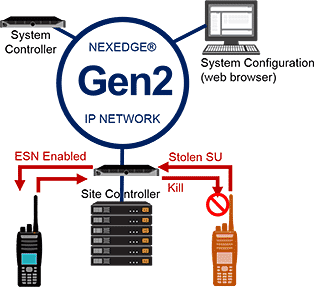 On an NXDN Gen2 system, in order to prevent unauthorized access and/or theft of radios, their electronic serial numbers are screened by the system. On access, the ESN of a radio is automatically checked; if an unauthorized person is trying to access the network, you can automatically initiate a stun or kill to disable the radio. You can also deal with radios that have been stolen or lost thanks to prescheduling. This helps to protect against the possible theft of network resources that are indispensable for the running of an organization – whether a police/fire department or a large-scale SMR operator. Configuration is browser-based for enhanced flexibility.
On an NXDN Gen2 system, in order to prevent unauthorized access and/or theft of radios, their electronic serial numbers are screened by the system. On access, the ESN of a radio is automatically checked; if an unauthorized person is trying to access the network, you can automatically initiate a stun or kill to disable the radio. You can also deal with radios that have been stolen or lost thanks to prescheduling. This helps to protect against the possible theft of network resources that are indispensable for the running of an organization – whether a police/fire department or a large-scale SMR operator. Configuration is browser-based for enhanced flexibility.
Interoperability
Adopted Models:P25
The ability to communicate and coordinate among multiple public safety agencies and departments is essential for mission-critical operations. So the unsurpassed interoperability of the NX-5000 Series is especially advantageous: as well as supporting 3 digital protocols – P25 Phases 1 & 2 – in addition to FM analog, it also offers a rich feature set and future-ready/future-proof capabilities.
Centralized System Management
Adopted Models:NXDN
Sophisticated network system management software reduces operation and maintenance costs. It offers such features as remote programming, firmware uploading, subscriber unit access management, monitoring and diagnostic capabilities – all from a secure Windows® -based application via direct connection, IP connection or dial-up modem. Access is limited to authorized personnel only.
Operators can monitor site traffic in real time for management and troubleshooting purposes. They can also download the detailed call activity of any channel site, individual or group for traffic, security and incident analysis. System Manager will graph peak usage and blocking statistics to identify possible system traffic and/or capacity issues.
Comprehensive subscriber privileging is provided: UID/GID validation, 127 UID/127GID Class-of-Service entries and 5,000 Fleet UID/GID lists permit operators to grant certain access privileges, call types, inter-site call capabilities and queue priority for any groups and/or individuals on a system.
Other convenient facilities include NXR diagnostics – for remote monitoring of hardware and the Ethernet network interface to identify possible problems – and remote NXR firmware uploading.
Repeater Monitor
Adopted Models:NXDN
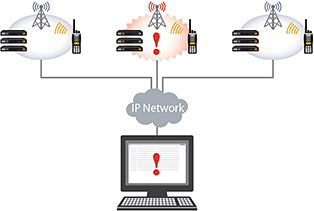 System monitor features provide for around-the-clock remote IP monitoring of all repeaters on an NXDN single-site or multi-site trunked network and on NXDN conventional IP networks. This software can alert supervisors and technical personnel to systemic problems or failures in any repeater at any site. Also the repeater monitor can be set to sound a PC alarm and send multiple emails or SMS text messages upon receiving an alert, with all events recorded in a log file.
System monitor features provide for around-the-clock remote IP monitoring of all repeaters on an NXDN single-site or multi-site trunked network and on NXDN conventional IP networks. This software can alert supervisors and technical personnel to systemic problems or failures in any repeater at any site. Also the repeater monitor can be set to sound a PC alarm and send multiple emails or SMS text messages upon receiving an alert, with all events recorded in a log file.
When a trunked network IP link is disrupted, the site reverts to single-site trunked operation and a network link message can be broadcast over the air, while an alert tone is sounded on the radios of the system operator and on-call technician.
- Repeater Diagnostics Via IP
- WAV Alarms
- Email/SMS Alert Notifications
- Log File Download
- Single-site Trunked & Multi-site Networks
- Conventional & Conventional IP
DMR AIS IP CI (Console Interface)
Adopted Models:DMR
DMR AIS (Application Interface Standard) is a voice/data communications protocol established by the DMR Association. With the AIS IP CI (console interface), it is possible to use the dispatch console installed at a base station (command station) to communicate with portable and mobile subscriber units via conventional repeaters with IP connections. A total of 10 IP consoles can be registered to a repeater, and up to 2 IP consoles can communicate simultaneously. For group registration, up to 20 group IDs can be registered simultaneously from an IP console.
Network Manager System & Client
Adopted Models:NXDN
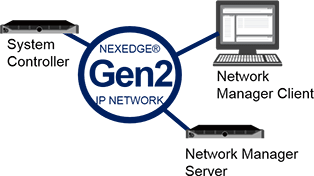 NXDN Gen2 employs a server-based network design with a system controller to ensure efficient system management. The addition of Network Manager System with Server & Client enables comprehensive monitoring of large-scale systems with multiple access points. Network assets are managed using the SNMP protocol, while all IP assets are managed with a single program.
NXDN Gen2 employs a server-based network design with a system controller to ensure efficient system management. The addition of Network Manager System with Server & Client enables comprehensive monitoring of large-scale systems with multiple access points. Network assets are managed using the SNMP protocol, while all IP assets are managed with a single program.
In addition to NXDN server and repeater monitoring, IP asset and network monitoring is also possible; this includes network traffic and load, network path, subscriber registration, latency, event and error monitoring. Other functions include network topology mapping; log acquisition and analysis; call log acquisition and analysis by group, site and call type; reporting and alert settings.
Use of SNMP provides flexible means for status monitoring of network hardware such as routers and switches, as well as Windows and UNIX servers. It also facilitates resource monitoring, performance monitoring, and traffic monitoring. Moreover, the system is compatible with commercially available network monitoring applications.
- KPG-1003NS Network Management Server Software
- KPG-1004NC Network Management Client Software
Direct Frequency Assignment (DFA) for efficient site/channel addition
Adopted Models:NXDN
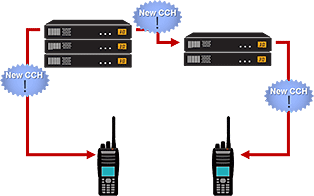 With the flexibility inherent in NXDN Gen2, you can always keep the system up to date easily and quickly. When adding a new channel or site with older Gen1 models, it has been necessary to collect every single SU on the network for reprogramming. Then all the radios had to be sent back into the field.
With the flexibility inherent in NXDN Gen2, you can always keep the system up to date easily and quickly. When adding a new channel or site with older Gen1 models, it has been necessary to collect every single SU on the network for reprogramming. Then all the radios had to be sent back into the field.
What has changed all this is DFA – Direct Frequency Assignment – which ensures that as soon as new frequencies are added to the network, all equipment and subscriber units connected to the network are notified automatically. No radios have to be called in. Downtime is zero. Nothing could be more welcome for site managers and SMR operators who want to add channels or sites.
Browser-based Multi-Access Configuration Tool
Adopted Models:NXDN
This is a browser-based configuration tool using a PC or mobile device to monitor, in real time, the access status of multiple users from multiple access points with access control. Once a firmware update is uploaded to the System Controller, the repeaters are automatically updated. This ensures that all repeaters on the network will always have the latest firmware version. Log management via the System Controller is also possible. And since this is a browser-based approach, flexibility is assured: as long as you are connected to the network, you can access the system from anywhere to configure network settings remotely.
Dual Functional Channel / Non-dedicated Control Channel
Adopted Models:NXDN
Complex systems require a dedicated control channel (CCH), but it is not easy to set up such a channel in a way that is cost-effective. However, NXDN Gen2 employs an elegant solution: the control channel and traffic channel (TCH) temporarily exchange roles to expand air capacity. Thanks to this Dual Functional Channel feature, you can enjoy the same level of performance as provided by a dedicated control channel but without having to make a large investment. This approach also maximizes traffic capacity without increasing the number of frequencies, and maintains an even load distribution on the repeaters. For sites with limited traffic, this solution makes a lot of sense.
Linux Server-based System Architecture
Adopted Models:NXDN
NXDN Gen2 employs a Linux server-based system architecture that offers a level of reliability that is second to none. This enables superior, fine-grained control of networks, systems, sites and peripheral equipment – including the ability to modify a setup and conduct maintenance/monitoring remotely.
OTAP: Over-The-Air Programming
Adopted Models:NXDN
The OTAP Manager software provides wireless programming for subscriber units in the field. Over-the-air programming (OTAP) results in huge savings for large fleets, which previously incurred considerable travel, labor and fuel costs, as well as suffering lost productivity from radio downtime.
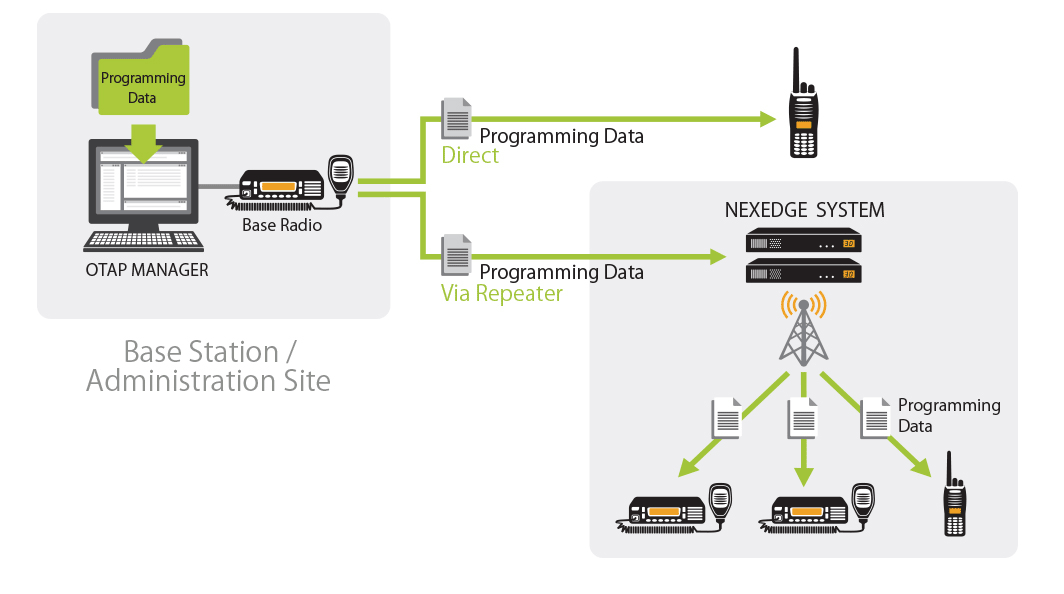
OAA: Over-the-Air-Alias
Adopted Models:NXDN
A calling unit's User ID (UID) alphanumeric alias is sent over the air (OAA) and displayed on the receiving unit's LCD, so there is no need to program every fleet alias in every radio.
